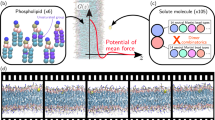Abstract
Purpose. To develop an efficient method for generating representative conformations for calculation of the conformationally dependent molecular surface area, and to investigate the relation between this parameter and the permeability in Caco-2 cells.
Methods. High temperature molecular dynamics (MD) simulations were used to obtain 1000 conformations of six beta-blocking agents and their prodrugs. The Boltzmann averaged (B.a.) polar surface area of the 1000 conformations was correlated to the apparent permeability coefficients (Papp) for transport across filter-grown Caco-2 cells.
Results. Sampling of 1000 conformations during the MD simulations was sufficient for obtaining a representative set of conformations. The B.a. polar water accessible surface area (PWASA) yielded an excellent linear correlation with Papp for both series of compounds under study (R2 = 0.98). Thus, the improved permeability of the prodrugs could be explained by a reduced PWASA. The improvement of permeability after derivatization correlated positively with the size of the non-polar water accessible surface area—suggesting a synergistic effect of the cyclopropyl and the non-polar parts of the molecule to shield the polar parts from contact with water.
Conclusions. An efficient method for generating the representative conformations for calculation of the B.a. polar surface area has been established. An excellent linear correlation explaining the improved permeability of the prodrugs was obtained.
Similar content being viewed by others
REFERENCES
C. A. Lipinski, F. Lombardo, B. W. Dominy, and P. J. Feeney. Experimental and computational approaches to estimate solubility and permeability in drug discovery and development settings. Adv. Drug Del. Rev. 23:3–25 (1997).
B. H. Stewart, O. H. Chan, N. Jezyk, and D. Fleisher. Discrimination between drug candidates using models for evaluation of intestinal absorption. Adv. Drug Del. Rev. 23:27–45 (1997).
H. van de Waterbeemd, G. Camenish, G. Folkers, and O. A. Raevsky. Estimation of Caco-2 cell permeability using calculated molecular descriptors. Quant. Struct-Act. Relat. 15:480–490 (1996).
C-P. Lee, R. L. A. de Vrueh, and P. L. Smith. Selection of drug development candidates based on in vitro permeability measurements. Adv. Drug Del. Rev. 23:47–62 (1997).
H. Ellens, P. E. Eddy, C.-P. Lee, P. Dougherty, A. Lago, J.-N. Xiang, J. D. Elliott, H.-Y. Cheng, E. Ohlstein, and P. L. Smith. In vitro permeability screening for identification of orally bioavailable endothelin receptor antagonists. Adv. Drug Del. Rev. 23:99–109 (1997).
R. A. Conradi, A. R. Hilgers, N. F. H. Ho, and P. S. Burton. The influence of peptide structure on transport across Caco-2 cells. Pharm. Res. 9:435–438 (1992).
K. Chikhale, K. Ng, P. S. Burton, and R. T. Borchardt. Hydrogen bonding potential as a determinant of the in vitro and in situ blood-brain barrier permeability of peptides. Pharm. Res. 11:412–419 (1994).
D. Kim, P. S. Burton, and R. T. Borchardt. A correlation between the permeability characteristics of a series of peptides using an in vitro cell culture model (Caco-2) and those using an in situ perfused rat ileum of the intestinal mucosa. Pharm. Res. 10:1710–1714 (1993).
K. Palm, K. Luthman, A. Ungell, G. Strandlund, and P. Artursson. Correlation of drug absorption with molecular surface properties. J. Pharm. Sci. 85:32–39 (1996).
H. van de Waterbeemd and M. Kansy. Hydrogen-bonding capacity and brain penetration. Chimia. 46: 299–303 (1992).
K. Palm, P. Stenberg, K. Luthman, and P. Artursson. Polar molecular surface properties predict the intestinal absorption of drugs in humans. Pharm. Res. 14:568–571 (1997).
B. Testa, P.-A. Carrupt, P. Gaillard, F. Billois, and P. Weber. Lipophilicity in molecular modeling. Pharm. Res. 13:335–343 (1996).
G. T. Knipp, D. G. Vander Velde, T. J. Siahaan, and R. T. Borchardt. The effect of β-turn structure on the passive diffusion of peptides across Caco-2 cell monolayers. Pharm. Res. 14:1332–1340 (1997).
U. Werner, T. Kissel, and W. Stüber. Effects of peptide structure on transport properties of seven thyrotropin releasing hormone (TRH) analoges in a human intestinal cell line (Caco-2). Pharm. Res. 14:246–250 (1997).
J. Hochmann, P. Leppert, K. Strong, C. Tang, and K. Prendergast. Eur. J. Pharm. Sci. 5(suppl. 2): S48 (P6) (1997).
I. T. Christensen and F. S. Jørgensen. Conformational analysis of six-and twelve-membered ring compounds by molecular dynamics. J. Comput.-Aided Mol. Design. 11:385–394 (1997).
L. Hovgaard, H. Brøndsted, A. Buur, and H. Bundgaard. Drug delivery studies in Caco-2 monolayers. Synthesis, hydrolysis, and transport of O-cyclopropane acid ester prodrugs of various β-blocking agents. Pharm. Res. 12: 387–392 (1995).
SYBYL, Tripos Associates, St. Louis, MO, USA.
Spartan, Wavefunction Inc., Irvine, CA, USA
M. J. S. Dewar, E. G. Zoebisch, E. F. Healy, and J. J. P. Stewart. AM1: A new general purpose quantum mechanical molecular model. J. Am. Chem. Soc. 107:3902–3909 (1985).
R. S. Pearlman(*) and J. M. Skell. SAVOL3: Numerical and analytical algorithms for molecular surface area and volume, software distributed by the author, College of Pharmacy, University of Texas, Austin TX 78712, USA.
R. S. Pearlman. Molecular surface area and volume: their calculation and use in predicting solubilities and free energies of desolvation. In W. J. Dunn III, J. H. Block and R.S. Pearlman (Eds.), Partition coefficient. Determination and estimation. Pergamon Press, Great Britain, 1986, pp. 3–20.
Modde 3.0, Umetri AB, Umeaa, Sweden.
I. Shinkai and P.J. Reider. 1,2,5-Thiadizoles. In A. R. Katritzky, C. W. Rees and E. F. V. Scriven. (Eds.), Comprehensive Heterocyclic Chemistry II. A review of the literature 1982–1995. The structure, reactions, synthesis, and uses of heterocyclic compounds, R. C. Storr (vol. Ed.) Volume 4, Five-membered rings with more than two heteroatoms and fused carbocyclic derivatives, Pergamon, 1996, pp. 355–377.
F. H. Allen and O. Kennard. 3D search and research using the Cambridge Structural Database. Chem. Design Automation News 8:31–37 (1993).
Author information
Authors and Affiliations
Rights and permissions
About this article
Cite this article
Krarup, L.H., Christensen, I.T., Hovgaard, L. et al. Predicting Drug Absorption from Molecular Surface Properties Based on Molecular Dynamics Simulations. Pharm Res 15, 972–978 (1998). https://doi.org/10.1023/A:1011905522110
Issue Date:
DOI: https://doi.org/10.1023/A:1011905522110




